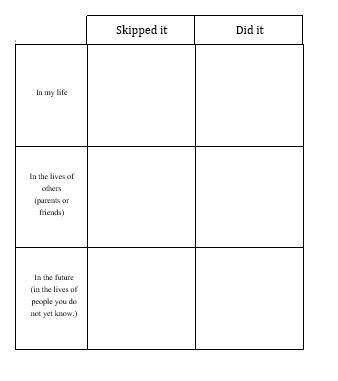Motivation for the Sake of Self vs. Other
The central idea of this concept is that some people are more motivated if they think what they’re doing is benefiting others in the community around them, especially altruistic motivation. Here’s an example of what this chart aims to do: Let’s say Sam isn’t doing well in math class, but he wants to go into elementary teaching. He will learn math for the sake of his future students and not necessarily for the sake of himself. By doing this, he can change his perspective on math class. His work in math class suddenly becomes something more than just a means to slip by through high school. It becomes a part of a larger journey for him to be of service to others in the future. This concept is a leap for many students. Students can take note of their weaknesses and the ideas presented in this concept as well as how they can directly apply the concept in their daily lives.
Thinking about the benefit of their school work on those in their lives (often their parents) is the first time they will look at developing empathy. Other sessions in the program will continue to develop the concept of empathy, but this is the first time empathy is directly addressed. Some students find that they are more focused when their motivation for others is stronger than their motivation for self. This is a step in the right direction.
Being that this concept sometimes adds stress for many students, the main goal is just solely to introduce students to this kind of thinking. Some students are already used to using this type of thinking and excel. Some students have a hard time with this. The point is for students to be able to understand and put this concept to use. We’ll continue to go over the idea of empathy, especially in sessions 7, 8, and 9 of the Academic Life Coaching program.
From the Academic Life Coaching Workbook
Here’s a chart for you to map out the pain and the benefits that happen when you achieve the outcome you want and add what will happen in your own life and the lives of others when you follow through.
Note: When thinking about the impact in the lives of others, it’s not necessary to have an answer. It can be difficult to think about the benefit of getting all A’s and B’s will be on your family 20 years from now. However, it’s still useful to think about the impact on how your decisions now will affect the future.
Below, fill out this chart on the outcome you want.

Mission
To provide life coach training that changes lives, launches careers, and promotes human flourishing.
contact@academiclifecoaching.com
PO Box 2021
Hood River, Oregon 97031
This website is powered by
Mission
To provide life coach training that changes lives, launches careers, and promotes human flourishing.
contact@academiclifecoaching.com
PO Box 2021
Hood River, Oregon 97031
Mission
To provide life coach training that changes lives, launches careers, and promotes human flourishing.
contact@academiclifecoaching.com
PO Box 2021
Hood River, Oregon 97031
This website is powered by